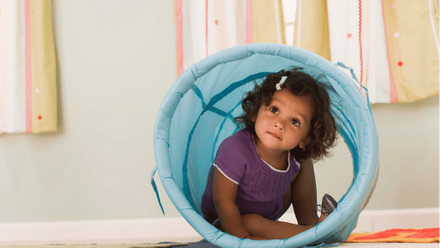Understanding the physical activity guidelines in early years

What happens when you are a child has a direct impact on your behaviours much later in life. If you’ve experienced positive physical activity and movement experiences during the early years, you’re more likely to grow up making healthier choices and to be more in control of your own wellbeing needs.
This is vital, as research suggests that almost 1 in 4 children are overweight or obese by the time they start school and only one in ten children aged two to four are meeting the UK Physical Activity Guidelines. The guidelines state that pre-schoolers should spend at least 180 minutes (three hours) per day in a variety of dynamic activities spread throughout the day, including active and outdoor play.
The UK Physical Activity Guidelines at a glance
Infants (less than one year old)
Infants should be physically active several times every day in a variety of ways, including interactive floor-based activity, such as crawling. For infants not yet mobile, this includes at least 30 minutes of tummy time spread throughout the day while awake, and other movements, such as reaching and grasping, pushing and pulling themselves independently, or rolling over; more is better. Tummy time may be unfamiliar to babies at first, but can be increased gradually, starting from a minute or two at a time.
IMPORTANT: babies should not sleep on their tummies and should be supervised closely during tummy time activity.
Toddlers (one to two years old)
Toddlers should spend at least 180 minutes (three hours) per day in a variety of physical activities at any intensity, including active and outdoor play, spread throughout the day. Again, more is better.
Pre-schoolers (three to four years old)
Pre-schoolers should spend at least 180 minutes (three hours) per day in a variety of physical activities spread throughout the day, including active and outdoor play. The 180 minutes should include at least 60 minutes of moderate to vigorous intensity physical activity.
Pregnant women and new mothers
There is a wealth of benefits for activity during pregnancy and after giving birth. Women are encouraged to achieve 150 minutes of physical activity per week, continuing with usual activity if already active or safely increasing activity if currently inactive. There are some activities that the NHS recommend women avoid during pregnancy and, as always, if you start to feel unwell, consult your medical practice immediately. Exercise does not have to be strenuous to be beneficial.
Exploring the Physical Activity Guidelines in the early years in more detail
The guidelines emphasise the importance of being active every day and spell out the recommended minimum levels of activity for each age group. A key message of the guidelines is that, for all age groups, some physical activity is good, but more is better. Even the lowest levels of activity bring a multitude of benefits, and therefore everyone should be encouraged to do what they can.
The Physical Activity Guidelines guidelines are:
UK wide |
|
This set of guidelines apply to all four home countries and are endorsed by all four Chief Medical Officers. |
Evidence-based |
|
The guidelines are based on comprehensive reviews of research evidence and take account of publications which consider the revised guidelines in other developed countries such as USA, Australia and Canada. |
For everyone |
|
These guidelines cover all age groups across the lifespan including guidelines for early years (0-5 years) and for pregnant women and new mothers. |
Prevention-focussed |
|
The recommendations are based on prescribing a minimum level of physical activity to benefit health and focus on prevention of disease and are therefore not disease specific. |
Apply to everyone, but consider individual differences |
|
These guidelines apply to all, irrespective of gender, race, or socio-economic status, but should be interpreted with consideration of individual physical and mental capabilities. |
Global guidelines issued by the World Health Organisation emphasise this further and make recommendations not only for physical activity but also sleep and sedentary behaviour. The overall goal of these guidelines is to provide recommendations on the amount of time in a 24 hour period that under-fives should spend being physically active for their health and well-being.
Early childhood education and care settings have a unique opportunity to promote healthy eating, physical activity, and adequate sleep for young children that will help them develop healthy behaviours through their childhood and beyond.
WHO Guidelines 2020
Key takeaways
The WHO guidelines are designed to help early education and care professionals understand the type and amount of physical activity under-fives should do to benefit their health. Early education and care settings and professionals have a responsibility to make sure that this guidance is translated into practice so that we can help children and their families make wise and healthy choices.
Further resources and readings
There are a vast amount of exciting resources available to give you great ideas about getting active. This could include the PANCo training programme available via NDNA.





